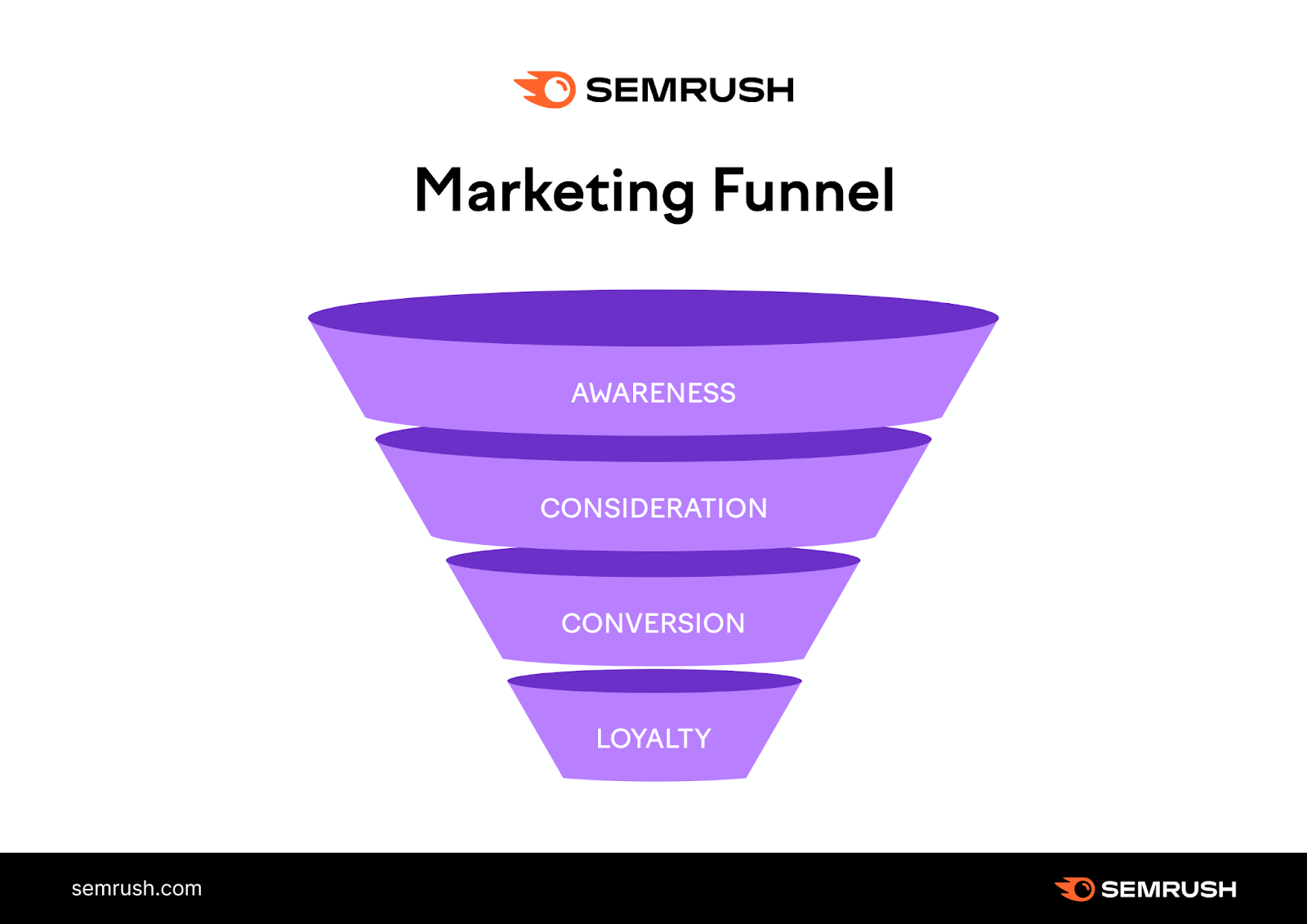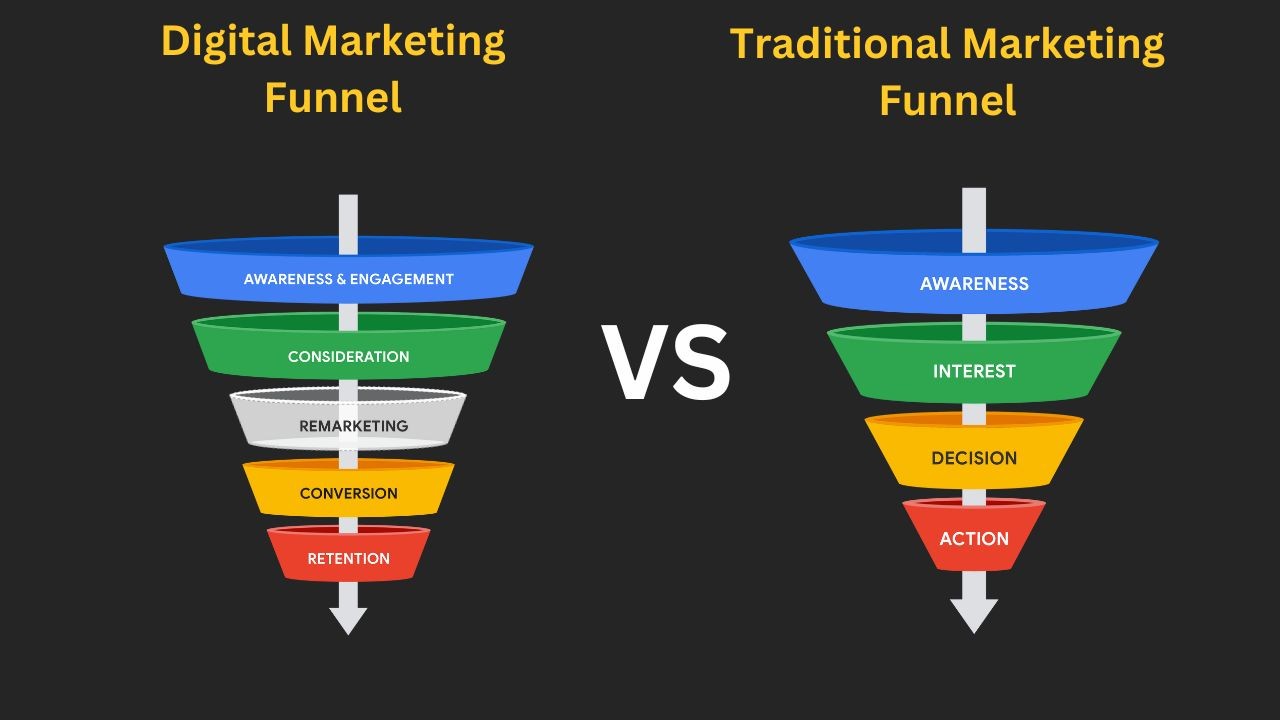The goal is to attract leads, nurture them, and convert them into paying customers. Digital marketing funnels are an essential part of any successful online marketing strategy. They help businesses understand their customers’ journey and create tailored content to drive conversions.
By implementing a digital marketing funnel, businesses can improve their overall sales and ROI. In this blog, we will discuss the four stages of a digital marketing funnel and provide tips on how to optimize each stage for maximum results. Whether you’re a small business owner or a marketing professional, this guide will help you create an effective digital marketing funnel.
Introduction To Digital Marketing Funnels
The digital marketing funnel is an essential concept in online marketing. It has evolved over time to become a crucial tool for maximizing ROI. Funnels help businesses understand the customer journey from awareness to conversion and beyond. They allow marketers to identify the most effective strategies and tactics at each stage of the funnel, ultimately driving better results.
By analyzing the various touchpoints and interactions within the funnel, businesses can optimize their marketing efforts and improve customer engagement. Funnels provide valuable insights into consumer behavior, allowing marketers to tailor their messaging and offers to specific audiences. This targeted approach increases the chances of conversions and boosts overall ROI.
Whether it’s attracting new prospects, nurturing leads, or converting customers, funnels are instrumental in guiding users through the marketing journey. By leveraging data and analytics, businesses can continuously refine their funnel strategies and adapt to changing market dynamics, ensuring long-term success in the digital landscape.
Components Of A Successful Marketing Funnel
A successful digital marketing funnel consists of several key components. The first stage is awareness, where the goal is to reach your target audience through various online channels such as social media, search engines, and display advertising. This is achieved by creating engaging content and utilizing effective targeting strategies.
The next stage is interest, where the focus shifts to engaging potential customers and capturing their attention. This involves providing valuable and relevant information to your audience, building trust, and establishing your brand as an authority in your industry.
Conversion: Turning Interest Into Action
To optimize landing pages for higher conversion rates, it is essential to implement effective call-to-action strategies. The main goal is to turn the initial interest of website visitors into concrete actions, such as making a purchase or filling out a form.
One important aspect is to create compelling and clear call-to-action buttons that stand out on the page. Using action-oriented words like “Buy Now,” “Sign Up,” or “Get Started” can encourage users to take the desired action. Additionally, placing the call-to-action buttons prominently on the page, preferably above the fold, can increase their visibility.
Another strategy is to provide a sense of urgency or scarcity in the call-to-action. For instance, offering limited-time discounts or highlighting limited availability can motivate users to act quickly. Additionally, using social proof, such as customer testimonials or reviews, can build trust and credibility, making visitors more likely to convert.
In conclusion, optimizing landing pages for conversion involves implementing effective call-to-action strategies. By creating compelling buttons, using urgency or scarcity, and incorporating social proof, you can increase the likelihood of turning visitor interest into action.
Nurturing Leads Through The Funnel
When nurturing leads through the digital marketing funnel, email marketing tactics play a crucial role. Email campaigns can effectively engage potential customers and guide them towards making a purchase. By personalizing emails and crafting compelling subject lines, you can capture the attention of your audience. A well-designed email sequence allows you to provide valuable content, showcase product benefits, and address any objections or concerns. Additionally, retargeting and remarketing strategies can be employed to re-engage individuals who have shown interest but haven’t yet converted. By displaying tailored advertisements to these prospects across various platforms, you can reinforce your brand message and encourage them to take the desired action. Through strategic email marketing and targeted retargeting, you can nurture leads throughout the digital marketing funnel and maximize your conversion rates.
Closing The Sale: Techniques That Convert
| Incentivization and Urgency: Offering incentives to customers can be a great way to close the sale. This can include discounts, free shipping, or bonus items. Creating a sense of urgency can also be effective, such as limited time offers or low stock alerts. However, be careful not to overdo it and come across as too pushy. |
| Streamlining the Checkout Process: A complicated checkout process can lead to cart abandonment. Simplify the process by minimizing the number of steps, offering guest checkout, and using autofill for shipping and billing information. Also, make sure to display clear and transparent pricing and shipping information. |

Credit: www.semrush.com
Loyalty And Advocacy: Post-purchase Strategies
After a successful purchase, post-purchase strategies can nurture customer loyalty and advocacy. Digital marketing funnels play a crucial role in engaging and retaining customers through personalized content and targeted promotions. By leveraging these strategies, businesses can build lasting relationships with their customers and drive repeat purchases.
| Loyalty and Advocacy: Post-Purchase Strategies |
|---|
| After a customer has made a purchase, it is important to focus on retaining them for future business. This can be achieved through customer retention programs that reward loyalty and encourage repeat purchases. These programs can include exclusive discounts, personalized offers, and VIP access. Additionally, encouraging social proof through customer reviews and testimonials can help build trust with potential customers. Referral programs can also incentivize current customers to refer their friends and family, expanding the reach of your business. By implementing these post-purchase strategies, you can turn satisfied customers into loyal advocates for your brand. |
Analyzing Funnel Performance
When analyzing the performance of your digital marketing funnel, it is essential to track key metrics that provide valuable insights into your conversion rates. These metrics help you understand how well your funnel is performing and identify areas for optimization.
One important metric to track is the conversion rate, which measures the percentage of visitors who take the desired action. By monitoring this metric, you can determine the effectiveness of your funnel in converting visitors into customers.
Another crucial metric is the bounce rate, which indicates the percentage of visitors who leave your website without taking any action. A high bounce rate may suggest issues with your landing page or targeting strategy, requiring further investigation.
Furthermore, tracking the average time spent on your website can provide insights into visitor engagement. If visitors spend a significant amount of time on your site, it indicates their interest and engagement with your content.
Lastly, analyzing the click-through rate (CTR) of your calls-to-action (CTAs) can help identify areas for improvement. A low CTR may indicate that your CTAs are not compelling enough to encourage clicks, requiring adjustments to enhance their effectiveness.
Credit: www.linkedin.com
Leveraging Technology In Your Funnel
The digital marketing funnel is a crucial aspect of any successful online strategy. Leveraging technology in your funnel can greatly enhance its effectiveness. Automation tools are a valuable asset that can streamline processes and improve efficiency. These tools can automate repetitive tasks, such as email marketing campaigns and social media scheduling, saving you time and effort. Additionally, AI technology can be utilized to personalize the customer experience and boost engagement. By using AI algorithms, you can tailor content and recommendations to individual users, increasing their satisfaction and likelihood of conversion. Embracing these technological advancements in your digital marketing funnel can help you stay ahead of the competition and achieve your business goals.
Future Trends In Digital Marketing Funnels
The future of digital marketing funnels is evolving rapidly, with VR and AR set to play a pivotal role in captivating audience attention. These immersive technologies will enable brands to create engaging and interactive experiences, leading to higher conversion rates. Additionally, the utilization of predictive analytics and customer insights will empower marketers to tailor their strategies to individual preferences, resulting in more personalized and effective campaigns. By leveraging these advancements, businesses can expect to see increased engagement, improved customer satisfaction, and ultimately, enhanced ROI.
Conclusion: Maximizing Your Marketing Funnel
Maximize your digital marketing funnel by focusing on optimizing each stage. From attracting potential customers to nurturing leads and converting sales, a well-crafted funnel can significantly impact your business’s success. By leveraging the right strategies and tools at each stage, you can enhance your overall marketing performance.
When it comes to maximizing your marketing funnel, it is important to follow some best practices. Recap these practices to take action and improve your ROI. First, ensure that your funnel is optimized for mobile devices, as mobile usage continues to rise. Next, focus on personalized and relevant content that speaks directly to your target audience. Utilize data and analytics to track and measure the performance of your funnel, making necessary adjustments along the way. Don’t forget the importance of lead nurturing, as it can significantly impact conversion rates. Lastly, consider implementing retargeting strategies to re-engage potential customers who have shown interest in your brand. By implementing these practices, you can effectively guide your audience through the digital marketing funnel and drive successful outcomes for your business.

Credit: firstpagesage.com
Frequently Asked Questions
What Is Search Funnel In Digital Marketing?
Search funnel in digital marketing refers to the process of a user’s journey from search to conversion. It includes awareness, consideration, and decision-making stages. By understanding the search funnel, marketers can optimize their campaigns for each stage and improve conversion rates.
What Are The 5 Stages Of The Marketing Funnel?
The 5 stages of the marketing funnel are: 1) Awareness- making potential customers aware of your brand, 2) Interest- getting them interested in your product or service, 3) Consideration- making them consider purchasing from you, 4) Conversion- getting them to make a purchase, and 5) Loyalty- retaining them as loyal customers.
What Is A Digital Marketing Funnel?
A digital marketing funnel is a step-by-step process to guide potential customers towards making a purchase. It includes awareness, interest, decision, and action stages. This strategy helps businesses to attract, engage, and convert leads into customers through targeted marketing efforts.
What Is The Seo Funnel For Digital Marketing?
The SEO funnel for digital marketing is a strategy to attract, engage, and convert potential customers. It involves optimizing content, building backlinks, and targeting relevant keywords to drive traffic and increase conversions on a website.
Conclusion
In a nutshell, understanding the digital marketing funnel is crucial for successful online campaigns. By recognizing the stages of awareness, consideration, and conversion, businesses can effectively target and engage their audience. Implementing strategic content and utilizing the right channels can drive leads and conversions, leading to business growth and success.
